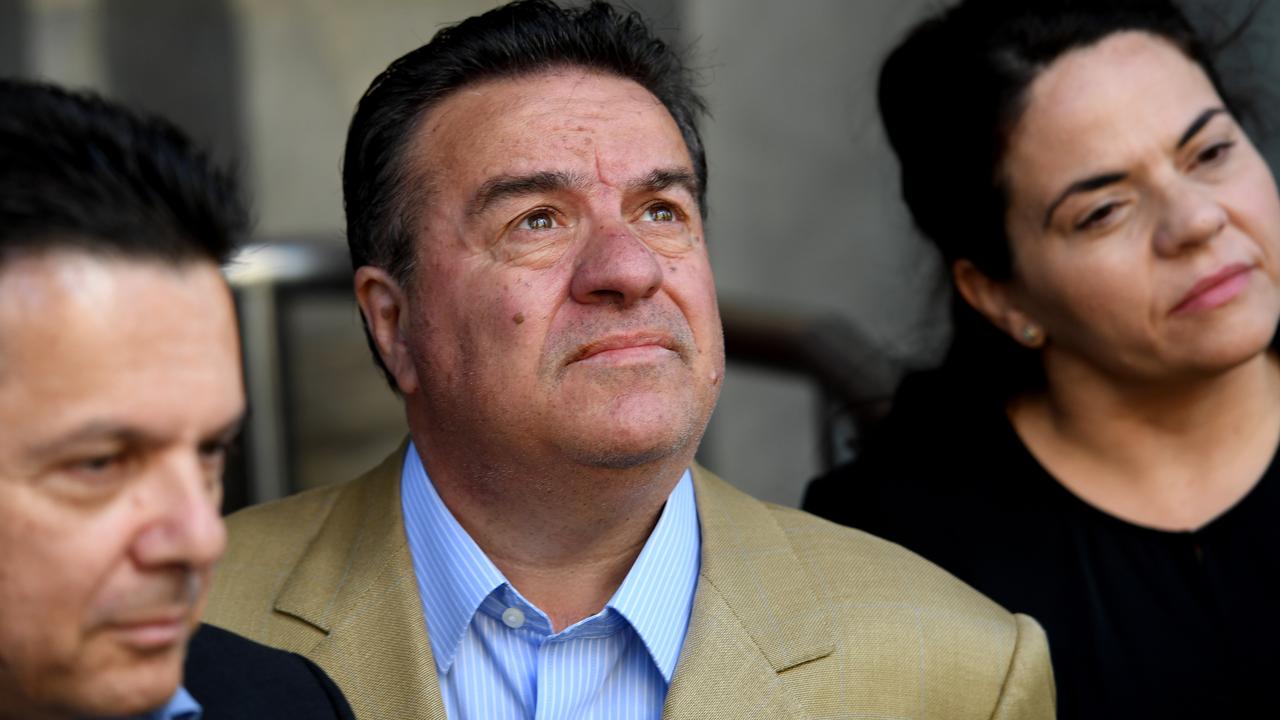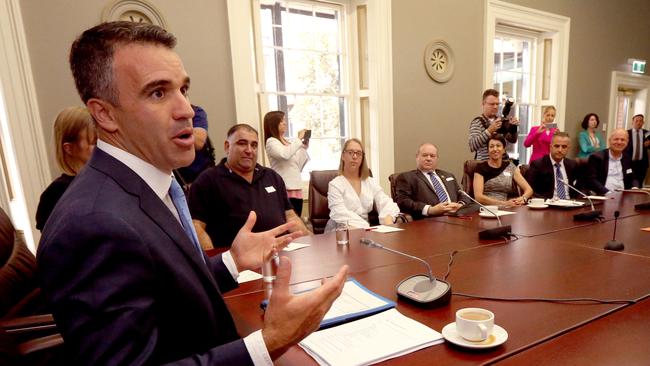Paul Starick: Premier Jay Weatherill’s strengths and weakness to deliver office
PREMIER Jay Weatherill is a shrewd political operator who defied the odds to return to power at the last state election. We analyse the pluses and minuses now facing the nation’s longest-serving state leader. TAKE OUR POLL
SA 2018
Don't miss out on the headlines from SA 2018. Followed categories will be added to My News.
- Analysis: Nick Xenophon’s strengths and weaknesses
- Michael McGuire: SA in reverse takeover of the private sector
- Legal threat: Jay’s had enough of Hadd Enuf
- #Engage4ChangeSA: SA parties on notice over pay parity
- Jay: SA Best candidates will ditch party after election
- Debate: Which leader won — you decide by taking our poll
PREMIER Jay Weatherill is a shrewd political operator who defied the odds to return to power at the last state election. We analyse the pluses and minuses now facing the state Labor leader and nation’s longest-serving Premier.
STRENGTHS
EVEN before he held a Labor leadership position, it was clear that Jay Weatherill harboured the discipline, courage and acumen to play a long game.
This was patently obvious to observers when, the day after Labor’s narrow 2010 election victory, he announced live on The Advertiser’s website that he would take on Treasurer Kevin Foley for the deputy leadership.
Mr Weatherill staked out his political turf with a prepared mantra that he hoped would define him, a new approach to government based on a “debate and decide” model rather than “announce and defend”.
Mr Weatherill has been prepared to defy convention, to take on powerful, established figures and to withstand intense criticism while advancing his strategy in a measured, calm manner.
He has picked and won fights with Mike Rann (deposed as premier), factional chief Don Farrell (thwarted in his bid for state preselection) and Tony Abbott (submarines built in Adelaide).
About a year ahead of the March 17 election, Mr Weatherill staked out his ground again. He would fight for South Australia against powerful external forces trying to wreck the state.
Conflating parochialism with his Government’s interests, this has enabled Mr Weatherill to “stand up” against national electricity market failures and River Murray water rorts, for example.
Once again, his ability to plan a strategy well in advance and execute it with discipline and skill make him a formidable opponent.
WEAKNESSES
LABOR is shooting for a historic fifth term in office and, while the party has regenerated effectively, the baggage of 16 years at the helm starts to mount up.
The big-ticket items that Mr Weatherill has opened were commissioned by Mr Rann’s government — projects such as Adelaide Oval, the new Royal Adelaide Hospital and the expanded Adelaide Convention Centre.
Although Mr Weatherill has cleverly built the narrative of CBD rejuvenation, he is campaigning more on the vibe than a substantial list of bricks-and-mortar achievements.
Governments own a state’s successes and failures.
PODCAST: OFF THE RECORD - EPISODE 3
South Australia has problems with confidence and image. While these are largely undeserved, Mr Weatherill’s government has been hammered interstate — in particular for the statewide blackout in September 2016. South Australians are sick of the jokes about whether the lights are still on.
Domestically, Mr Weatherill’s government has been embroiled in scandals over child protection, aged care at Oakden, TAFE accreditation and health system failures. Even Mr Weatherill’s beloved citizens’ juries were a dismal failure when applied to plans to expand South Australia’s role in the nuclear fuel cycle.
If he is to win in March, Mr Weatherill will have to convince the electorate that he is not mired with these failures and the state is not adrift.
OPPORTUNITIES
FOR a Premier who has held office for more than six years, Mr Weatherill has managed to maintain a surprising freshness to his agenda.
Whatever the policy merits, the embrace of renewable energy, and Elon Musk in particular, has given him the chance to appear forward-thinking and innovative.

Young people, in particular, are generally supportive of renewable energy and believe Mr Musk to be a cool, daring entrepreneur.
Likewise, steel and energy magnate Sanjeev Gupta has embraced Mr Weatherill’s vision and last week declared SA would soon have a surplus of energy, making it an attractive place for energy-intensive industries to set up operations.

Politically, Mr Weatherill has shrewdly and surgically attacked SA Best leader Nick Xenophon, trying to pin him to unpopular federal government decisions and brand him as a closet Liberal.
Unlike Liberal rival Steven Marshall, though, Mr Weatherill has not ruled out forging a deal with Mr Xenophon to return to government.
He also has proven negotiating abilities with independents — just ask Geoff Brock — should they, rather than SA Best, hold the balance of power.
THREATS
MULTIPLE and varied threats, ranging from the “time for a change” factor to the X factor — the popular support for SA Best — might consign Mr Weatherill to political oblivion.
After years in the wilderness, the Liberals might capitalise on a favourable electoral redistribution, rise above past campaign blunders and sweep to power. In particular, Labor might underestimate Steven Marshall after the 2014 election.
Mr Weatherill will have been paying close attention to the complicated national electricity market in recent weeks, desperately hoping to avoid widespread blackouts.
He will be praying for mild weather in the next few weeks, lessening the chances of his government being fatally tarred with the financial and reputational cost of another grid failure.
Labor has maintained government through clever, targeted campaigning in a handful of metropolitan marginal seats.
Opinion polls have shown low primary support, so firing up the base might not be enough if the key swinging voters abandon the party.
Likewise, Mr Weatherill will become SA’s second-longest serving leader (after Sir Thomas Playford and ahead of John Bannon and Mike Rann) if, as he has predictably vowed, he serves a full term if re-elected. Although a handover would be expected, voters might baulk at creating another one-party dynasty.
The shutdown of Holden’s Elizabeth plant last October has not triggered the employment meltdown feared by some. Instead, jobless figures have been quite buoyant, even if the state has a large proportion of public sector jobs.
Arguably, the biggest threat to Mr Weatherill’s re-election chances is a collapse in confidence, making voters believe he does not offer a sustainable vision or drive to grow the state economy, creating jobs and prosperity for future generations.
TOMORROW: STEVEN MARSHALL’S STRENGTHS AND WEAKNESSES



